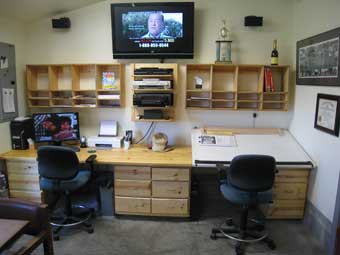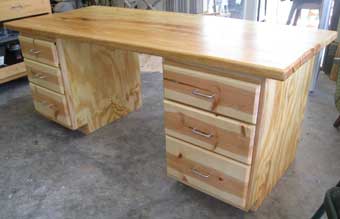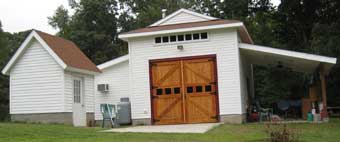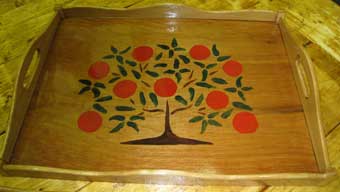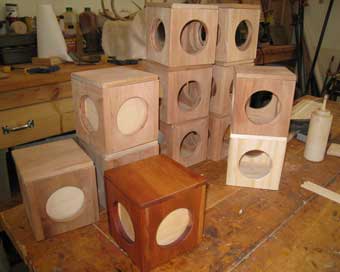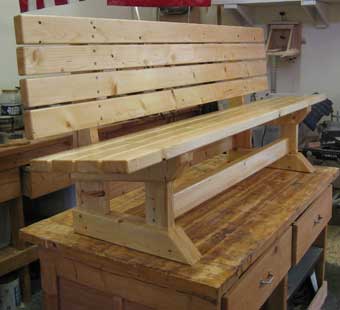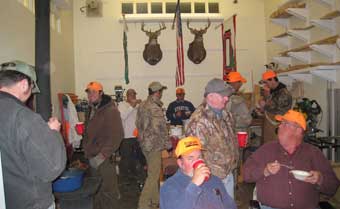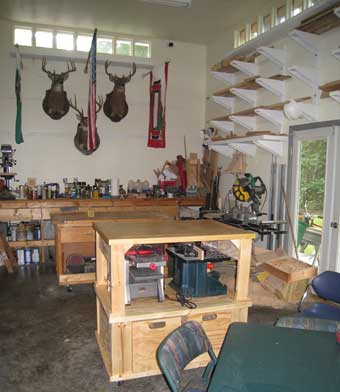
You might remember that old classic folktale about the witty rabbit and the malicious fox. Brer Rabbit cleverly tricks the fox: “Do whatever you please,” said Brer Rabbit, “Only please, Brer Fox, please don’t throw me into the briar patch.” Just as Brer Rabbit got what he wanted when he was tossed into the briar patch, Henry Hiner, too, throws himself into his own “Briar Patch” – the name he has given to the multi-use workshop he began building three years ago.
Since 1998, he has resided at his home in Caret, Virginia, which is also commonly referred to as a briar patch because of its characteristic prickly plants. Because of the terrain, and the fact that he just likes that old tale, Hiner chose that nickname for his woodworking escape.
He graduated in 1966 from Ohio State University, where he achieved a bachelor of arts degree at the Knowlton School of Architecture. Hiner, now 67, retired from his career as an architect three years ago, which freed up his time to build himself a workshop to expand his woodworking hobby.
For years, Hiner has helped people build sheds, decks and other outdoor projects. However, due to lack of space and tools, he was never able to make indoor projects such as cabinets, dressers or desks. This dilemma prompted him to construct a workshop upon his retirement.
Hiner says the best feature of his workshop is the “multi-use”. The Briar Patch is divided into three main sections. The first is the office area, which is 12×18 feet and contains a pine desk that he built, a computer with Internet access, a high-definition TV, radio, counter, microwave and other necessities.
The middle section – the shop – is where all the woodworking happens.
“Keep the office area separate from the shop,” is his advice for those who are building a workshop of their own. “It is important,” he explained, “to have a door you can close to protect from all the dust.”
This 16x24ft. area includes his workbench, miter saw, sander, router table, jointer, shaper, and even a refrigerator and freezer. The 13-feet-tall ceilings give the space a much more open feel. The top of the walls – near the ceiling – are lined with glass windows that allow natural light to flood down and illuminate the shop.
“It’s not dark in there during the day,” he chuckled as if speaking an understatement.
The final division of the workshop is the 12x18ft. back porch area where he keeps his larger items like the table saw, air compressor and barbecue grill.
After spending about two years completing this grand task, he can now fully use and enjoy it. Hiner gets lost in his Briar Patch for an average of 16 hours a week in the shop and two to three hours a day in the office. Of course, he does have to leave his shop at some point, since plumbing is one of the only features not included in his woodworking getaway.
Despite the fact that he constructed an entire workshop, Hiner still considers himself a beginner in his woodworking career. Before he had his shop, he didn’t even own a router table or miter saw, so he wasn’t able to start “woodworking” on furniture and smaller items until three years ago.
He is a self-taught craftsman who uses sources such as woodworking magazines and websites to progress his skill. But what makes this woodworker unique is his extensive background in architecture. His favorite part of woodworking is the “design aspect” because he gets a chance to incorporate his architectural expertise in his woodworking.
“I don’t really use a pattern except for the one I make up.”
When someone requests him to build something, they may show him a plan, but he tends to only use that as a starting point because he likes to make his own plans.
“I just do my own thing,” he says. And it seems to be working quite well for him.
Because of his eye for design, Hiner’s favorite wood is pine. He says it is softer and can easily be found in 2×4 and 2x6s. Another reason this wood strikes his fancy is because, “While some might see it as a problem in their woodworking,” he explained, “I like to use the colors in the heartwood to add something to my pieces.”
Another handy trait possessed by this woodworker is his ability to design and construct on a cost-effective budget. For example, he built the lumber rack in his shop with one sheet of plywood and 6-8 2x4s for $50. Also, for under $800, he made the doors to his Briar Patch, which are 9x9ft. and made of 2-1/2″-thick Spanish cedar and pine.
Several times a year, different people ask Hiner to build certain items for them. However, he never charges them for more than the cost of the materials. He once made 14 birdhouses for a woman who gave them as Christmas gifts. He enjoys what he does and gives many of his pieces away as gifts, like his trays and candleholders. Of course, he keeps certain projects for himself, like his workbench and items that add to the Briar Patch.
One of his favorite projects that stands out to him is the photo cube. Crafted from cherry, the cube sits on a 3″ lazy Susan base, with 3″ diameter holes for pictures which he puts a piece of acetate in front of. He also made 14 of these photo cubes for Christmas presents last year.
Currently, Hiner is finishing up a project for his friend who runs a roller-skating rink. It is a 72″ bench for people to sit on while they put on their skates.
When he’s not partaking in his other hobbies of gardening and golfing, you can find him back at his Briar Patch, entertaining a mass of hunters, a tradition that began in 2001, before his workshop even existed.
“But since I’ve had my workshop,” Hiner said, “it’s been even better and easier to do.”
Almost every Friday night during deer-hunting season, which goes from about the end of October to early January, up to 40 hunters bring all kinds of meat – beef, deer, alligator and more – to his shop and have a barbecue with all the fixin’s, including baked beans and pies.
Now that Briar Patch doesn’t seem like it would be so terrible to be thrown into. Although being retired usually means not having to work so hard, one thing’s for sure – this woodworking retiree is keeping himself busy in the Briar Patch.
